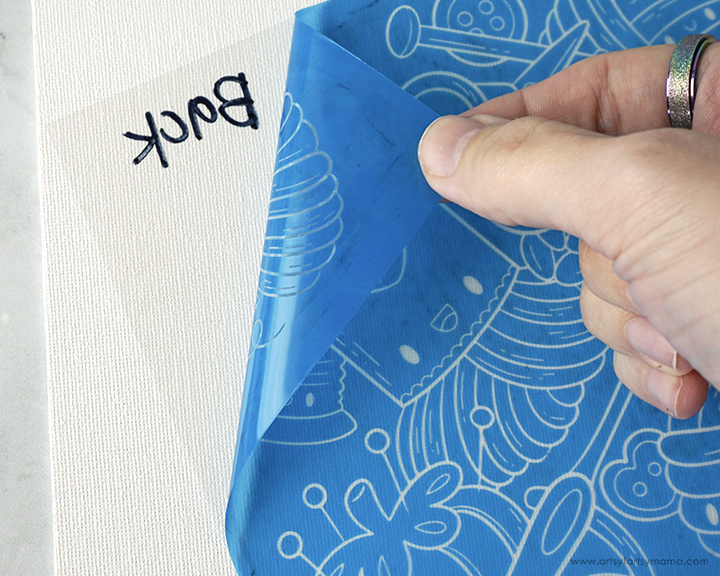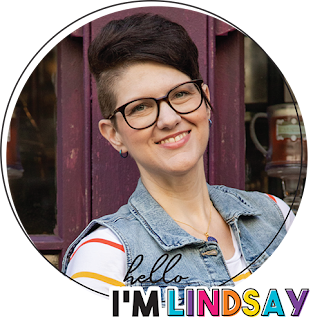Display a hand-painted work of art with this clever DIY Coloring Book Canvas trick!

For me, painting is be a fun and relaxing hobby. However, I have a lot of friends who disagree because they say that they're not "artsy-fartsy". I was trying to think of how to help my artistically-challenged friends (and even kids) to feel confident about creating art, and the idea of a coloring book on canvas came to mind. This project was made using a simple canvas panel and a custom stencil (thanks to my Ikonart kit). I think it is such a fantastic way to create your own art, or you could transfer the design to multiple canvases that kids of ALL ages can paint at parties. I've been so excited to share this project with you, and hope you feel inspired to try it out for yourself.
New to making reusable stencils? Here's how to Get Started with Ikonart!

To make your own Coloring Book Canvas, you will need these supplies:
- Coloring Page Design or Drawing
- 8"x8" Canvas Panel
- Ikonart Custom Stencil Kit
- Chalk Paint or Acrylic Paint - black
- Squeegee
- Paint Markers
*Save 15% on Ikonart supplies when you shop with code AFM15

To make a stencil, you need to start with a printed design. For this project, you can use any coloring page design, or even draw your own creation! I used an adorable sewing/crochet/knitting design to hang in my craft room. Print the design as dark as possible on either inkjet or laser Ikonart Printer Film or draw directly on the film using a black permanent marker.
The next step in the process is exposing the stencil film. Set up the exposure stand with UV LED Light by following the directions included in the kit. Ikonart Stencil Film is light sensitive, so be careful to keep it out of sunlight and bright lights before exposure. Cut a piece of the film the same size as the design print.
Lay the piece of film down on the base of the stand with the textured side facing up. Place the printed design on top of the stencil film, making sure it's right-side up - meaning that you should be able to read the words printed on the design.
Lastly, place the clear exposure sheet (found in the stencil film pack) on top and press it down well to seal the design tight against the stencil film. Turn the exposure light on and expose the film for 35 seconds.

The final step in the stencil-making process is to washout, or rinse the stencil. Clip the exposed stencil film to the Ikonart clipboard with the shiny side (carrier sheet) touching the clipboard. Use the kitchen sink sprayer to rinse the stencil film with warm water until the design shows through and becomes completely clear. The washout process shouldn't take more than 3 minutes.
Gently blot the excess water from the stencil, and hang or lay the stencil flat to dry for about 45 minutes. When the stencil is dry, you shouldn't see any water spots or discoloration. Once the stencil is completely dried, place the it back on the exposure stand and expose it again for at least 2 minutes without the clear cover sheet. This extra exposure time will increase the durability of the stencil so you can get as much use out of it as possible.

Peel the carrier sheet away from the stencil and set it aside (don't throw it away). Center the stencil on the canvas panel. Carefully rub the stencil down and apply pressure to help it stick to the surface and to get rid of any air bubbles trapped underneath.

Apply a line of acrylic paint* or chalk paint at the top of the stencil (but not too close to the edge). Gently pull the squeegee down over the stencil until the open areas are all evenly covered. Scrape away the excess and put it back onto the paint tray or bottle.
*Because acrylic paint has a thinner consistency, you are more likely to have trouble with bleeds on stencil projects. Chalk paint is thicker than regular acrylic paint, so it helps to create crisp lines when stenciling. To thicken your acrylic paints (any brand or type), I recommend mixing in a little bit of chalk paint powder.
Just add a little bit of powder to the paint and stir it together with a craft stick. Add a little more powder at a time, if necessary, until you get the consistency you want.
If you're not sure what type of paint to use on your project, Ikonart has a list of paint and ink selections to help you out!

Chalk paint is thicker, but it also dries quicker than regular acrylic paint. After covering the top section of the design with paint, lift the stencil up to reveal that part and then gently lay the stencil back down (don't add pressure or anything). This simple step will help to prevent the paint from drying in the mesh and lifting up with your stencil later.
If you lift it up and see any spots that you may have missed, carefully lay the stencil back down and add a little more paint. Once every part of the stencil has been covered, peel the stencil away. If you notice any missed spots or bleeds after the stencil is removed, grab a small detail paint brush and add a light coat of paint over the area(s).
Repeat the process to add your image to multiple canvas panels without washing the stencil in between (unless you have bleeds). This is a great way to create multiple copies of the design on canvases to use for birthday parties, paint nights, and more!
Let the canvas(es) dry completely, and wash the stencil well following the instructions below.
Washing Stencils:
For best results, wash stencils while the paint is still wet. To wash your stencil so that it can be used again and again, first get the clipboard wet so your stencil doesn't stick to it. Place the stencil on the clipboard with the textured side up, and lightly rub the stencil under cold running water to remove all the paint.
Do not rub or scrub the adhesive side of the stencil, and NEVER use anything other than water to wash the stencils. To prevent the stencil from breaking down, don't ever leave the stencils to soak.
Remove the stencil from the clipboard and lay it down with the adhesive side up. While the stencil is still wet, place the carrier sheet onto the stencil so that the word “BACK” is readable. Hang or lay the stencil flat to dry completely.

The most important step is to HAVE FUN and be creative!

It's always a good feeling when a project turns out how you imagine. Needless to say, I am so happy with how this Coloring Book Canvas turned out and love how it looks in my craft room!! With all of the fine details in the image, Ikonart truly made this project so simple. I'm looking forward to hosting a paint night with friends using this technique again.
I'd love to hear what you think about this project, or if you want to know more about Ikonart stencils. If you've made your own stenciled projects, I would love to see your creations! Share them on Instagram, Facebook, or leave a comment/photo on the project pin on Pinterest! #AFMCrafts
Don't forget to Pin, Like, and Share!












